Pros
Cons
Introduction
Front
{{section_header}}{{section.name}}{{/section_header}}

Back
{{section_header}}{{section.name}}{{/section_header}}

Sides
{{section_header}}{{section.name}}{{/section_header}}

Top
{{section_header}}{{section.name}}{{/section_header}}

Bottom
{{section_header}}{{section.name}}{{/section_header}}

In the Box
{{section_header}}{{section.name}}{{/section_header}}

• The EX-G1 camera
• Wrist strap
• NP-80 battery
• BC-80L charger
• Wrist strap
• USB cable
• A/V cable
• Software CD-ROM
• Quick start guide
• Protectors
• Screws to attach protectors
• Lug to remove battery cover
The protectors are the small plastic strips that attach to the left side of the front of the camera to protect it from damage. Casio obviously expects these to take a beating, as the camera comes with one fitted, and with two additional ones.
Color
{{section_header}}{{section.name}}{{/section_header}}
In our tests on the accuracy of the colors that the EX-G1 captured, we found average results: the camera captured most colors pretty closely, but some were less accurate than others. In particular, we found that reds and yellows were somewhat off from the originals, with both colors looking more muted and less attractive than the originals. We test the color accuracy of cameras by photographing a color chart that has 24 color patches, and then by using Imatest to analyze the difference between the original (the first column on the chart below) and the camera's captured color (the second column). More on how we test color.
Color Modes
{{section_header}}{{section.name}}{{/section_header}}
The EX-G1 offers 8 color filters that can be applied as the image is captured, which include options for black and white, sepia, red, green, yellow, blue, pink and purple. We'd recommend avoiding the use of these as the effect is rather unpleasant and permanent: once you've shot an image using one of the filters, there is no way to undo it if you change your mind.
Noise
{{section_header}}{{section.name}}{{/section_header}}
Noise is the Achilles heel of digital cameras: the electronics that capture the image produce a small amount of electrical noise as they work, which shows up in the image as a grainy pattern that hides the details. This noise gets increased as the camera boosts the ISO sensitivity to make more use of the light. which is why your low-light images look grainier than the daylight ones. We didn't find that noise was a huge problem on this camera, though: it was present at all ISO levels, but didn't become a problem until the ISO was increased above 800. More on how we test noise.
We run our tests shooting with the EX-G1 at two different light levels: 3000 lux (about what you would get on a cloudy day outdoors) and 60 lux (indoor lighting). The noise levels remain pretty close in both tests, climbing above 2 percent at ISO 1600.
In the chart below, we compare the noise levels of this camera with others. As you can see, the EX-G1 did a pretty impressive job here: we found that the noise level remained lower than most cameras across the ISO range.
{{comparison_bars title="Noise Score Comparison", attribute="Noise Score", xLabel="Noise Score"}}
ISO
{{section_header}}{{section.name}}{{/section_header}}
The EX-G1 supports a wide ISO range of 64 to 3200, all at the full resolution of the camera. That's unusual; most point & shoot cameras only offer 3200 as an option with reduced resolution. Mind you, as the samples images below show, the image is extremely noisy at the higher settings, so they should only be used when absolutely required. Below are examples of photos taken at all of the ISO levels supported by the EX-G1 and all of our comparison cameras. Click on any image to see the full original file, but remember that the files are several megabytes in size and may take some time to download.
NOTE: The images above are not used in our testing or scoring, but are included here to show real-world examples of the differences between cameras at the various ISO settings.
Resolution
{{section_header}}{{section.name}}{{/section_header}}
Overall, we were less than impressed with the resolution of the images that we captured during our tests: they had significant distortion and chromatic aberration, as well as lacking sharpness, especially at the edges of the frame. More on how we test resolution.
Distortion ({{product.raw_scores['Distortion Score']}})
All of the images that we captured across the zoom range had some level of distortion in them: at the wide, mid and telephoto focus points, the images all had significant barrel distortion, where straight lines become bowed inwards like the sides of a barrel. You can see examples of this below, with the most significant distortion being at the wide angle setting.
Sharpness ({{product.raw_scores['Sharpness Score']}})
We found that the EX-G1 produced images that were extremely soft, with very little fine detail captured in them. Although the images have acceptable sharpness in the center of the frame, the edges of the images were very soft, with details getting lost in a blurry haze and . This happened across the zoom range: you can see examples in the crops below.
Chromatic Aberration ({{product.raw_scores['Chromatic Aberration Score']}})
We were also less than impressed with the amount of chromatic aberration in the images that the EX-G1 took: again, there was little at the center of the frame, but there was a lot at the edges of the image across the zoom range.
Quality & Size Options
{{section_header}}{{section.name}}{{/section_header}}
The EX-G1 offers 7 image sizes and three quality levels: fine, normal and economy. As the name suggests, fine takes the most space but has the highest quality. The camera estimates that you can fit 253 fine images at the highest resolution onto a 2GB micro SD card, and 721 in the economy mode at the same resolution.
Image Stabilization
{{section_header}}{{section.name}}{{/section_header}}
The EX-G1 includes a feature called Anti Shake, which they claim reduces the effect of subjective movement. We found that this feature made no difference: images were equally sharp when taken with a shaking camera with the mode off or in the Auto mode. We test these types of features by attaching the camera to our customized shake rig (which simulates a shaky hand) and examining the sharpness of images with the feature on or off. We didn't see any significant difference between the two tests, although to be fair, it may be that this feature just didn't enable itself in our tests: these focus on a shutter speed of 1/30 of a second, and the feature may not turn on at this shutter speed. More on how we test image stabilization.
Video Mode
{{section_header}}{{section.name}}{{/section_header}}
The Ex-G1 includes a number of video modes, including one that's designed for easy uploading to YouTube. These go into a special folder on the memory card, and software is included for Windows users that takes these and uploads them with just a couple of clicks. The other video modes on offer include a wide mode (with a resolution of 848 by 480 pixels) and a standard mode (with a resolution of 640 by 480 pixels). That's strictly standard definition resolution: this camera doesn't capture high definition video. All of these video modes store the video as a motion JPEG file, and mono sound is captured through the small microphone.
Unlike many other point & shoot cameras, this one allows you to use the 3x optical zoom while recording, and there was no discernible noise from the zoom mechanism. An additional 4x digital zoom is available, but this severely degrades the quality of the video, which is already pretty poor.
Video Color
{{section_header}}{{section.name}}{{/section_header}}
We found that the EX-G1 captured only lackluster video quality: several of the colors on our test chart were extremely inaccurately captured, with the yellows and reds in particular looking like pale imitations of the originals. Most cameras boost the saturation of the video to make the colors look more attractive, but the EX-G1 does the opposite, producing pale, flat colors. More on how we test video color.
{{comparison_bars title="Video Color Score Comparison", attribute="Video Color Score", xLabel="Video Color Score"}}
Video Sharpness
{{section_header}}{{section.name}}{{/section_header}}
We were also very unimpressed with the sharpness of the video; fine details in our test charts and other subjects were lost in a blurry haze unless the objects were completely stationary. Very few things stay that way in videos, so you won't see the details of peoples faces or the like in videos captured with this camera. More on how we test video sharpness.
{{comparison_bars title="Video Color Sharpness Comparison", attribute="Video Sharpness Score", xLabel="Video Sharpness Score"}}
Playback Mode
{{section_header}}{{section.name}}{{/section_header}}
The EX-G1 offers a decent selection of features to go through the images you have captured. You can view several levels of shooting information, as well as zooming in up to 16x on the image or viewing up to 25 thumbnails on screen at once. All of these features are easy to access by pressing the playback button on the rear of the camera body.
In-Camera Editing
{{section_header}}{{section.name}}{{/section_header}}
A number of basic image editing tools are offered on the EX-G1. Images can be rotated, resized and cropped, and there are a number of other editing tools. The Lighting feature offers two settings to brighten the image, and the Red Eye features tries to detect and remove red eye from an image. Unusually, you can also edit the white balance setting of an image, applying any one of 6 white balance presets to the image to try and correct the colors.
Basic video editing is also offered: you can flag and delete sections of a captured movie and create a motion print: a still image that contains either 9 or 3 frames captured from the video.
Direct Print Options
{{section_header}}{{section.name}}{{/section_header}}
The usual options for printing images directly are supported: you can flag images on a memory card using the DPOF format, or connect the camera directly to a printer that supports the PictBridge USB standard.
Viewfinder
{{section_header}}{{section.name}}{{/section_header}}
There is no viewfinder on this camera: everything is done through the LCD screen.
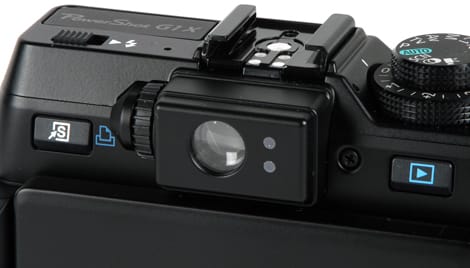

... and it has a diopter adjustment ring.
Display
{{section_header}}{{section.name}}{{/section_header}}
The EX-G1 has a 2.5-inch LCD screen on the back with about 230k pixels. That's an average size and resolution for a compact camera, but it does mean that the screen is smaller and grainier than many other cameras. Although the resolution is average, the screen is clear and bright, and is big and sharp enough to check the focus of an image without too much zooming in.

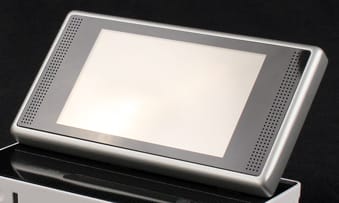
...but it turns into a nice 3-inch widescreen in playback mode.
Flash
{{section_header}}{{section.name}}{{/section_header}}
The small flash of this camera is located to the left of the lens. That puts it a little close to the lens, and this does mean that you see a lot of red eye. The camera tries to correct for this, though, both by offering a re-eye reduction flash mode and with an editing tool that detects and removes it.
There is also an unusual flash mode called Soft Flash, which uses a lower, longer flash that gives the image a slightly softer feel. In addition, this camera offers an LED recording light, which uses a small white LED to illuminate the scene. This makes it easier to see what you are taking a photo of, but it is pretty bright, and could irritate some subjects.

The flash emitter pops up from the top of the body via a mechanical release.
Lens
{{section_header}}{{section.name}}{{/section_header}}
The lens of the EX-G1 is a 3x zoom with a focal length of 6.6 to 19.8mm. That's equivalent to a 38 to 114mm lens on a 35mm film camera, which is a shorter range than many compact cameras. This is because of the thin profile of this camera and the completely enclosed nature of the lens: it doesn't come out of the camera body in use. The lens also has a very limited aperture range of f/3.9 to f/5.4.

Below are examples from the zoom range of the camera. As you can see, it has a decent wide angle, but doesn't provide a long enough zoom to reach the banner of our local cinema.
Battery
{{section_header}}{{section.name}}{{/section_header}}
The EX-G1 gets it juice from a small Li-Ion battery (mode number NP-80) that can hold only a rather small 700mAh of charge. This means that the battery life of the EX-G1 is limited. Casio claims a battery life of 300 shots, but we got significantly less than this in our informal tests.
The battery is also rather difficult to remove: you have to simultaneously pull back the latch and lift the cover. Fortunately, Casio has included a lug that makes it easier that can be attached to the wrist strap. This battery has to be removed from the camera to be charged: it cannot be charged within the camera. A spare NP-80 battery will cost you about $34.

Memory
{{section_header}}{{section.name}}{{/section_header}}
The EX-G1 has two memory locations: about 35.7MB of internal memory, and a microSD card slot that supports MicroSDHC cards. Casio doesn't specify the maximum supported card capacity, but the largest capacity cards currently available hold 8GB of data; enough for about 950 photos at the highest resolution and quality setting.

Jacks, Ports & Plugs
{{section_header}}{{section.name}}{{/section_header}}
A single port under a cover on the right side of the camera body connects the camera with the rest of the universe. This port can be used for connecting to a computer (with the included USB cable) or to a TV, with the included composite video cable. High-definition video is not supported. The USB port is a standard mini USB type, meaning that you can use a standard USB cable if you loose the included one: you don't have to buy a proprietary one.
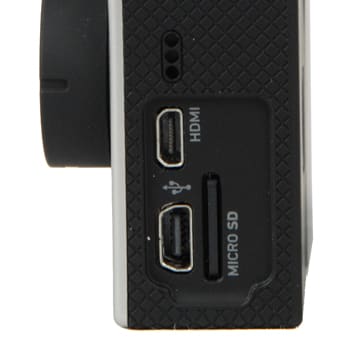
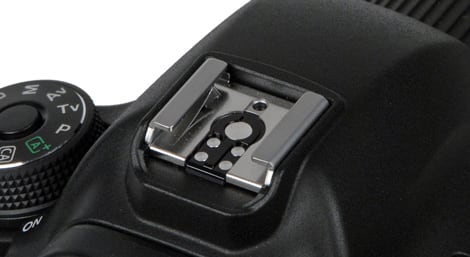
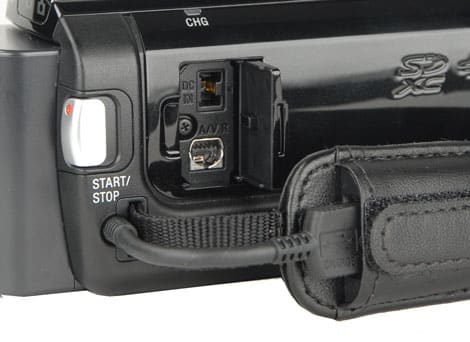
The DC-input and multi-AV port are located on the right side of the camcorder.
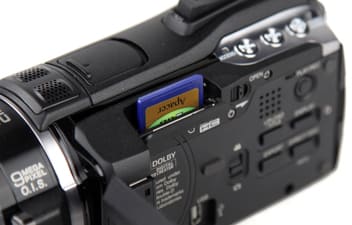
... as is the SD/SDHC card slot.
Other Hardware
{{section_header}}{{section.name}}{{/section_header}}
Waterproof
The EX-G1 is waterproof to a depth of 10 feet, which means it can be used for snorkel diving or other shallow underwater fun, but not for tank dives or diving to the Titanic.
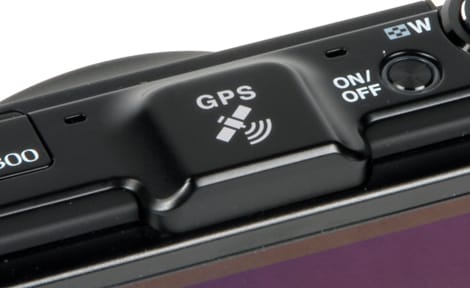
The new GPS module.
Drop-proof
The EX-G1 is built to withstand being dropped onto hard surfaces from heights of up to 7 feet.
Cold-proof
The EX-G1 can keep taking photographs in temperatures of down to 14 degrees Fahrenheit (around -10 degrees Celsius). Casio does warn that the battery life of the camera will be severely reduced at low temperatures, though.
Shooting Modes
{{section_header}}{{section.name}}{{/section_header}}
Several auto modes are on offer, including a full auto mode where the camera chooses the best settings to use. In addition, there is an Auto Best Shot mode, where the camera chooses one of the scene modes to use, and then makes decisions based on the settings of this scene mode.
Auto Mode Features
Focus - The contrast detection focus system of the EX-G1 was resonably effective: we found that it typically snapped into focus in less than half a second in good light. It is less effective in low light, though: in darkened rooms and at night it often failed to find the right focus point without the assistance of the front lamp to add more light to the scene to boost the contrast. A manual focus mode is also offered, as well as a mode called Pan Focus that sets the camera to close to infinity if you are taking panning shots.
Several options are available for how the camera chooses what to focus on, including an intelligent mode (which picks the focus point automatically from most of the frame), a spot mode and a multi mode that uses 9 focus points and tries to get as many into focus as possible. In addition, a tracking mode is available that focuses on an object in the center of the frame and tries to track and focus on it as it moves.
In macro mode, the EX-G1 can focus down to a distance of about 10cm (approx 3.9 inches) from the front of the lens. That's a pretty poor macro: you can't get close to small objects at that distance.
Exposure - If you think that the camera has picked the wrong shutter speed or aperture, you can push the exposure up or down by up to two stops,in one third of a stop steps. There is no option to automatically take a number of shots at a range of exposures, though (called auto exposure bracketing). You do get some limited control over the level of the flash, though; you get 5 flash level settings, from -2 up to +2.
Metering - The usual options for the metering pattern are present: you can use an evaluative pattern, a center weighted one or spot metering, which just measures the light level in a small patch in the center of the frame. Face detection can also be used, and this uses the faces as the critical elements to be correctly exposed for.
White Balance - The EE-G1 offers the usual selection of white balance presets, including those for daylight, shade, fluorescent, tungsten, etc. There is also an option for automatic white balance, and an option called manual which evaluates and sets the white balance. The name of this last one is somewhat confusing: it isn't a manual setting.
Aperture - The lens built into this camera has a disappointingly small aperture range: f/3.9 to f/5.4. That doesn't give it much room to gather more light at the wide end or to give a wide depth of field at the smaller apertures.
Shutter Speed - In most modes, the shutter speed of this camera can range from 1/2 of a second down to 1/1250 of a second. This is slightly expanded in the night shooting mode, which can go out to 4 seconds of exposure time.
Self Timer - The usual options of a 10-second and 2-second delay are on offer, as well as an unusual mode called x3 that waits 10 seconds, takes a photo, waits 2 seconds and takes another, then waits 2 seconds and takes a third.

The full mode dial is nice, but frequently rotates by accident.
Scene Modes
As usual with Casio cameras, a large number of scene modes are offered: 22 in total, including the usual suspects of portrait, night and Snow. A couple of unusual modes are on offer, though: Interval allows you to take a series of photos at a fixed interval (between 10 seconds and 3 minutes) over a fixed time (between 3 and 30 minutes). When you press the shutter, the camera will then take the images until the time runs out. The multi-motion image is also rather unusual: in this mode, the camera takes several images (9 or 3), isolates the moving object and pastes this over the static background in a single image. The idea is that you can then capture the movement of a footballer or skier in a single image. However, it does not work if the camera moves: it has to be static, and the process fails if there is any change in the background image.
The dynamic photo mode is also rather unusual: this tries to isolate a moving object in a photo and allows you to paste this moving image onto another photo. So, you could take a photo of the tiger enclosure at the zoo and have your kids running around in it without getting arrested for child endangerment. The process is a little fiddly and the results look a little rough, but it is kind of fun. One thing that is missing from this camera is any form of manual control. There is no way to directly set the shutter speed or aperture of the camera.
Picture Effects
{{section_header}}{{section.name}}{{/section_header}}
Should you want to turn your photos into a colorized monstrosity, the EX-G1 includes a number of color filters. We didn't find the results of these to be appealing, but examples of some are shown below.
Manual Controls
{{section_header}}{{section.name}}{{/section_header}}
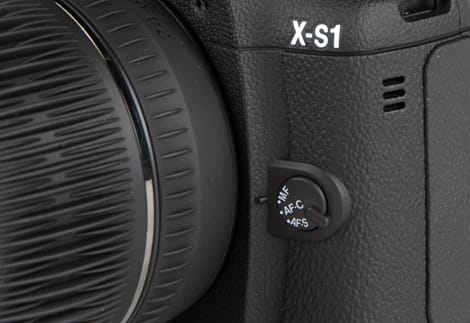
A dedicated focus-mode switch on the front panel.
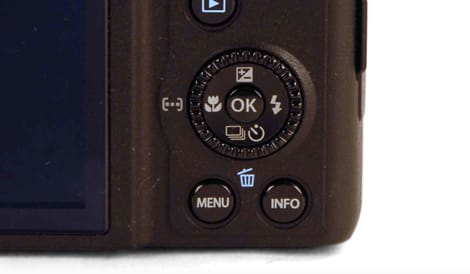
The scroll wheel surrounding the d-pad is neither awful nor perfect.
Drive/Burst Mode
{{section_header}}{{section.name}}{{/section_header}}
Two burst modes are available: a normal mode that shoots at the full resolution of the camera, and a fast mode that shoots 8 images at a lower resolution (2 megapixels). The normal mode can shoot to the capacity of the memory card: it does not slow down as images are written out.
Shot to Shot ({{product.raw_scores['Shot to Shot Score']}})
We measured the speed of the normal continuous shooting mode at 0.3 frames a second. That's one frame every three seconds, which is incredibly slow even by the pedestrian standards of most point & shoot cameras. The fast mode is significantly faster, fortunately, taking the 8 frames at a speed of 3 frames per second, albeit at a greatly reduced resolution.
Handling
{{section_header}}{{section.name}}{{/section_header}}
Thin cameras like the EX-G1 (at just 0.78 inches thick) are often awkward to hold, but this seems to be an exception to this rule: we found that it fitted well into the hand and was comfortable to hold. Raised ridges on the front and back also give the fingertips something to grip, so it is unlikely to slip. A wrist strap is also included that attaches to a loop on the back of the camera.




These dedicated buttons give you quick access to aperture and shutter speed controls.
Buttons & Dials
{{section_header}}{{section.name}}{{/section_header}}
The controls of the EX-G1 are grouped on the back of the camera body, to the right of the screen. These are mostly well placed, with the zoom control buttons and the movie start at the top so they fall under the thumb as you hold the camera. This means it is easy to zoom in and out and take photos or movies one-handed.

The other buttons require two hands, but again, they are well placed. Casio made the buttons different sizes and shapes to help with navigation by touch, and we found that this worked well; we were quickly able to switch to playback mode without having to search for the button.

Menus
{{section_header}}{{section.name}}{{/section_header}}
Casio uses two on-screen menus on this camera: pressing the down button of the directional control brings up the settings menu, while the menu button brings up the full menu. We found the settings menu pretty straightforward: you use up and down to navigate and left and right to select a setting. This makes changing things such as the ISO level or flash mode pretty simple.
The main menu is a little more awkward to use, with many options seemingly arbitrarily split between the rec and quality tabs. The anti-shake setting, for instance, is located in the REC menu, while the exposure compensation (it calls it EV Shift) is in the quality tab. An additional tab (called Set-up) is for other options, such as formatting the memory card.
Manual & Learning
{{section_header}}{{section.name}}{{/section_header}}
The printed manual that comes with this camera is limited to a short, one-sheet quick start guide that covers the basics of setting up and shooting with the camera. More detail is given in the main manual, available as a PDF on the software CD. This CD also includes Casio's own Photo Transport photo management software and the YouTube uploader software. Both of these are for Windows users only: no Mac software is included.
We found both the quick start and main manuals to be adequate: they cover the features of the camera in a good amount of detail and are mostly well written. Neither explains the more complex features that well, though; the explanation of the dynamic photo feature is confusing and too long.
Fujifilm FinePix Z33WP Comparison
These two cameras are quite similar in many ways: they are priced about the same, have a similar resolution and a similar zoom range. Both cameras are equally tough, handling water down to 33 feet, drops from 7 feet and temperatures down to 14ºF.
But they are different in other ways: the EX-G1 is very thin (at just 0.78 inches), while the D10 is a chunky camera that looks rather like a toy. But the advantage of being thicker is that the D10 has a better lens, which leads to better image quality: we found that the D10 images were much, much sharper than the EX-G1.
The deciding factor would be the balance between size and image quality. The Canon D10 is the better camera, but has a chunky, clunky design. The EX-G1 is much smaller, sleeker and more stylish, but takes worse photos.
Pentax Optio W80 Comparison
The Canon EX-G1 is twice the cost of the Z33WP, but it is also much tougher: it can go down to 33 feet underwater (the Z33WP is limited to 10 feet), is more shock-proof and can handle lower temperatures. We also found that the EX-G1 scored higher in many of our tests: it had lower noise, better color. But the Z33WP scored higher in our resolution tests: the images were sharper and more detailed by a significant margin.
Overall the decision between these two comes down to how you plan to use it. If you are just looking for a camera for days at the beach, the Z33WP will be fine; it can handle sand, surf and getting dropped. If you are planning any serious diving, go for the Casio, because it can handle deeper dives and lower temperatures.
COMP 3
The Casio is the tougher of these two camera, handling diving to depths of 33 feet and being dropped from about 6 feet (the Pentax can handle only 16 feet of water and about 3 foot drops). both cameras can handle equally cold temperatures, though: down to 14ºF (about -10ºC).
We found that the two cameras were mostly equally matched in terms of performance: they had similar color performance, but the W80 produced sharper images. However, it also had much more noise in the images, as the Pentax seems to be doing less to remove the noise. Both cameras were also similar in terms of video performance, producing video that lacked clarity and had weak color.
Conclusion
The Exilim EX-G1 is a small, stylish and tough camera: it is just 0.78 inches thick, but can take images at up to 33 feet down, and at temperatures of down to 14ºF (about -10ºC).
But these good looks don't carry over to the images: we found that while they had low noise, they were very soft. Especially at the edge of the frame, where sharp edges turned into blurry messes and fine details just weren't captured.
This is presumably because of the compromises that Casio had to make to pack a 3x waterproof and shock-resistant lens into this thin case. Most other cameras that are waterproof down to 33 feet are rather chunky, but the EX-G1 looks like a supermodel in mid diet.
It's also a slow camera to use, shooting just 1 frame every 3 seconds at the maximum resolution (you can shoot at 3 frames a second, but only at a 2-megapixel resolution). The colors the camera captured were mostly accurate, but were rather undersaturated and somewhat dull looking, making even bright blue skies look like gloomy days. This can be fixed in any image editing program, but it does make the images look less appealing at first glance.
Overall, the EX-G1 feels like a case of style over substance: it's a small stylish camera, but the images it captures aren't that good.
Photo Gallery
{{photo_gallery "Front Photo", "Back Photo", "Sides Photo", "Top Photo", "Bottom Photo", "Lens Photo", "Flash Photo", "EVF Photo 1", "EVF Photo 2", "LCD Photo 1", "LCD Photo 2", "Media Photo", "Modes Photo", "Manual Controls Photo", "Manual Controls Photo 2", "Other Controls", "Buttons 1", "Buttons 2", "Other Hardware Photo", "Battery Photo", "Ports Photo 1", "Ports Photo 2", "Ports Photo 3", "Ports Photo 4", "Handling Photo 1", "Handling Photo 2", "Handling Photo 3", "Box Photo"}}
Meet the tester
Richard Baguley is a veteran writer who has written about technology ranging from Alphabet to Zip file utilities. He has contributed to pretty much every major tech publication, including Amiga Format Magazine, PC World, Wired, CNET, Toms Guide, Forbes, and many others. He lives in the Boston metro area with his wife, dog, and an indeterminate number of cats.
Checking our work.
Our team is here to help you buy the best stuff and love what you own. Our writers, editors, and experts obsess over the products we cover to make sure you're confident and satisfied. Have a different opinion about something we recommend? Email us and we'll compare notes.
Shoot us an email